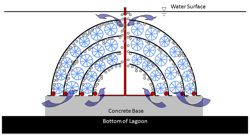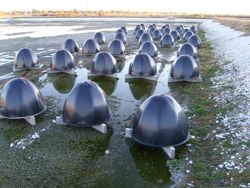Poo-Gloos
Air Date: Week of February 4, 2011

In between the layers of each Poo-Gloo are objects that provide surface area for bacteria to grow. Dirty wastewater enters through the bottom, and after the bacteria remove harmful materials, the water exits through the top. (Courtesy Taylor Reynolds)
At a time when rural communities everywhere are scrambling to make ends meet, new igloo-shaped devices have emerged that promise to generate big savings on wastewater treatment costs. According to project supervisor Aart Bahr of Gresham, Wisconsin, “poo-gloos” remove harmful materials from wastewater in an efficient, and cost-effective way. He tells host Bruce Gellerman how they work.
Transcript
GELLERMAN: Like a lot of small towns, the village of Gresham, Wisconsin has a
big and growing problem: an ever tightening budget and an ever-increasing
amount of waste water. So Gresham - population 600 - is trying an experiment for its sewage: a poo gloo. That's "gloo" as in "igloo" and "poo" as in - well, you know. Art Bahr, the Administrator of Gresham, says the makers of the poo-gloo want to see if the igloo shaped device can handle wastewater during a Wisconsin winter.
BAHR: Right now it goes into a lagoon where there’s bacteria, or bugs if you want to call 'em, that eat at the waste and they take and turn that into oxygen and get rid of all the sludge and heavier materials.
GELLERMAN: But in the cold that doesn’t work so well.

![]()
A set of Poo-Gloos waiting to be submerged in a wastewater lagoon.
(Courtesy Taylor Reynolds)
![]()
BAHR: No, in the cold the bugs slow down and don’t like to do their job quite as well.
GELLERMAN: And that’s where these poo gloos come in.
BAHR: Yes. The poo gloos, actually they’re starting to rename them right now - they’re starting to call them biodomes. They wanted to go with a little better terminology for ‘em.
GELLERMAN: Cleaning up their act.
BAHR: Yeah, cleaning up their act in more ways than one.
GELLERMAN: So how actually does a poo gloo work?
BAHR: If you can picture in your mind what a Russian doll looks like - how you can pull the little parts away and there are other little dolls inside.
GELLERMAN: Yeah, the matroshka - the little nesting dolls.
BAHR: Yeah, if you look at that, the top half - there’s seven little nests inside of those domes. There’s seven little smaller domes within it. And in between each of the domes there’s plastic material that the bacteria live on. And, it’s a fixed-film technology. The bacteria live on it, and what we do is we just supply air to them - and the air circulates the water throughout it so the bacteria can eat away at the solids that are in it.
GELLERMAN: So since you have this nesting system, basically what you’re doing is increasing the area - the surface area for the bacteria to grow - you’ve got more area.
BAHR: Yeah, that’s basically what we’re doing. We’re creating a really nice home and a larger home for the bacteria to live.
GELLERMAN: And they work, even in the cold?
BAHR: Yes. They seem to work fantastic in the cold.
GELLERMAN: And how much do these poo gloos cost?
BAHR: They’re about five thousand dollars a piece.
GELLERMAN: Ooh, that’s pretty stiff!
BAHR: It’s stiff, but they’re a long-term item. As long as you treat the bacteria good and give them the environment to live in, they should last for many years.
GELLERMAN: How many of these gloos did you have to buy?
BAHR: Well, right now all we’re doing is we’re just doing a pilot. So, one unit, and everything seems to be working fantastic with this one. Now what will happen is, once we get our data back, it appears that between our two ponds, we’ll have to put in 34 of these poo gloos - we’ll have to put in 17 in each pond.
GELLERMAN: So, at five thousand dollars a pop - a poo gloo - now what is that? A hundred and thirty…thirty thousand dollars?
BAHR: Yes. Now, when you talk about the money of it, we’ve talked about upgrading our ponds to meet the Wisconsin DNR’s statutory requirements for discharge. Now if we do it using older technologies, we’d actually have to put a cover over our pond to keep the pond water warmer - and doing that would cost us approximately 325,000 dollars.
GELLERMAN: Whoa - that’s a pretty stiff bill!
BAHR: Yes, for a small utility, we have two hundred and 75 customers, so we try to do everything economically that we can. We’re the first one in the Midwest to do this - and so the DNR is watching us very closely…
GELLERMAN: The DNR - the Department of Natural Resources - there in Wisconsin?

![]()
In between the layers of each Poo-Gloo are objects that provide surface area for bacteria to grow. Dirty wastewater enters through the bottom, and after the bacteria remove harmful materials, the water exits through the top.
(Courtesy Taylor Reynolds)
![]()
BAHR: Yes, and they’re appreciating all of the data that they’re getting from this. It’s pretty neat that a small town such as ours has a project that could set a trend for a lot of mid-western cold-weather lagoon systems.
GELLERMAN: And it’s not everyday you get to say poo gloo with a straight face.
BAHR: Yes. (Laughs). It’s quite something every time you put it in your computer and it wants to spell it ‘G-L-U-E.’
GELLERMAN: But it’s spelled ‘gloo’. Poo gloo, or biodome, as the makers Wastewater Compliance Systems, prefer. You can see photos of the novel device, and Art Bahr, the Administrator of the village of Gresham, Wisconsin, at our web site L-O-E dot org.
Links
Links: Wastewater Compliance Systems are the makers of Poo-Gloos.
Watch an above-the-surface walkthrough of Gresham’s pilot Poo-Gloo program.
Living on Earth wants to hear from you!
Living on Earth
62 Calef Highway, Suite 212
Lee, NH 03861
Telephone: 617-287-4121
E-mail: comments@loe.org
Newsletter [Click here]
Donate to Living on Earth!
Living on Earth is an independent media program and relies entirely on contributions from listeners and institutions supporting public service. Please donate now to preserve an independent environmental voice.
NewsletterLiving on Earth offers a weekly delivery of the show's rundown to your mailbox. Sign up for our newsletter today!
 Sailors For The Sea: Be the change you want to sea.
Sailors For The Sea: Be the change you want to sea.
 The Grantham Foundation for the Protection of the Environment: Committed to protecting and improving the health of the global environment.
The Grantham Foundation for the Protection of the Environment: Committed to protecting and improving the health of the global environment.
 Contribute to Living on Earth and receive, as our gift to you, an archival print of one of Mark Seth Lender's extraordinary wildlife photographs. Follow the link to see Mark's current collection of photographs.
Contribute to Living on Earth and receive, as our gift to you, an archival print of one of Mark Seth Lender's extraordinary wildlife photographs. Follow the link to see Mark's current collection of photographs.
 Buy a signed copy of Mark Seth Lender's book Smeagull the Seagull & support Living on Earth
Buy a signed copy of Mark Seth Lender's book Smeagull the Seagull & support Living on Earth

